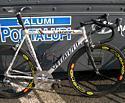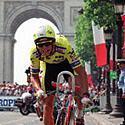
Recently on Cyclingnews.com |
Tech News – March 30, 2004Edited by John Stevenson Got tech? Send press releases, news, and tech questions to the Cyclingnews tech-heads. New wheels on the horizon from Mavic
Mavic's venerable Cosmic Carbone wheels are a popular choice in the peloton among Mavic-sponsored riders; they make a good time trial rear wheel when conditions make a disc impractical, but a bit of aero advantage is still worth having.
But just lately we've been noticing a new version of the Carbone on top riders' bikes (and thanks to the many readers who have emailed asking us about them too - you folks don't miss much!). Unlike the previous Carbone, the new incarnation doesn't have an aluminium rim, so it should be substantially lighter. Cynics that we are, we initially suspected that Mavic-sponsored riders were using someone else's wheels and getting them thoroughly stickered-up. But close examinaton of the photos reveals a very Mavic hub in there - these are definitely mavic protos. Mavic USA's Mike Berlinger confirmed our suspicions. "Yes they're new," Berlinger told Cyclingnews, " but that's all I can tell you right now. We'll have more info soon." Interestingly, the proto all-carbon Carbones are appearing under sprinters at the moment. The pics here are both from Milan San Remo and show Mario Cipollini's Specialized with the new wheels, and a close-up of the wheels on Alessandro Petacchi's Dogma clearly shows the all-composite rim construction. Where are the aero helmets?In development from Giro, it seems
Time trial stages of the year's first few tours have been marked by the absence of a once-standard piece of equipment. Instead of the aerodynamic helmets once popular among time trial specialists, riders have been lining up in the start hut in their standard lids, sometimes with clear covers over the vents to improve the aerodynamics a little. According Eric Richter of helmet manufacturer Giro, the change has come about for a simple reason: the UCI has mandated protective helmets during competition. The old time trial helmets, which Richter refers to as "fairings" offer no protection against impact, so are no longer allowed.
As you'd expect from the company that famously put an aero helmet on Greg LeMond for his 1989 Tour de France time trial victory, and has supplied Lance Armstrong with fairings for multiple wins, Giro is working feverishly on a new time trial helmet. "We've already tested a whole range of designs and ideas in the wind tunnel, and we're now into the real development," Richter told Cyclingnews. "You will see a new aero helmet from us at the Tour de France." Making the new helmet as aerodynamic as the fairings will be a challenge, Richter admits, but he thinks it's doable. "We have the benefit of working with the best TT riders in the world (including Lance, Eki, and David Millar), and our development team has an amazing record of raising the bar with new helmets, so I wouldn't bet against it," said Richter. "The goal for the new helmets is to meet or exceed the performance of the Rev IV and Rev V fairings, which were the benchmarks for aerodynamic performance. That's not going to be an easy task by any means, but we have the tools and we're very committed to providing our riders with the best equipment possible. I believe we can meet the challenge." We know from letters from Cyclingnews readers that there's strong demand for an aero helmet that meets the regulations, and Giro is aware of this too, but Richter couldn't say if the helmet being developed for Giro's sponsored pro racers or the clear covers being used on Pneumo helmets, would be available to mere mortals. "There are just too many variables to a consider," said Richter. "Right now we're focused on one priority: to deliver amazing aero helmets to Lance and our Division 1 teams. Once that's done, we'll be able to assess the options for consumers." In the meantime, Catlike, LAS, Limar and Louis Garneau all currently offer aero helmets that meet the new regulations (thanks to Cyclingnews reader Ben Faulk for that info). Check your brakesAfter a recent accident in Australia in which a cyclist was injured when her front brake pulled away from the fork, road bike riders are being urged to check that the front brake is properly fitted to their bikes. Almost all modern road bike brakes are mounted to the fork using a cylindrical hex key nut that inserts into the back of the fork crown and engages the brake center bolt. The depth of the fork crown varies between bikes, and carbon fiber forks in particular can have quite deep crowns. These crowns require a longer nut to properly engage the centre bolt. If a nut is used that's too short, then it's possible for the brake to become detached from the bike with potentially hazardous results. While this problem seems to be rare, it's straightforward enough to check for it. The nut should turn at least six times before it disengages from the centre bolt - if it unscrews with fewer turns, then a longer nut is needed. According to our local Shimano office, centre bolts for Shimano brakes are available in four lengths: 10.5mm, 12.5mm, 18mm and 25mm. Dura-Ace brakes for aftermarket use come with 12.5mm, 18mm and 25mm, and the fitting instructions say, "For sunken nut type brakes, use sunken nuts of the appropriate length which can be turned six times or more; when re-installing, apply sealant (locking adhesive) to the nut threads." By the way, we're emphatically not implying that Shimano has a particular problem here - but there are a lot of Shimano brakes out there, so the parts situation is a useful illustration, and Shimano's instructions apply to just about any safety-critical threaded fastener on a bike. Johnson on adidas
Tim Johnson, the former Saturn rider who this year has made the big leap across the pond to ride for the Spanish Saunier-Duval Division I team, will use adidas shoes and accessories such as arm- and leg-warmers this year. In an arrangement that's becoming quite common among European pros, Johnson is not bound by team sponsorship for his footwear. Some teams have footwear sponsorships that cover the whole team whereas others, such as T-Mobile, have a mixture. About half of T-Mobile uses adidas shoes, but Alexandre Vinokourov, for example, is sponsored by Italian shoe maker DMT. Johnson will be using adidas' two top models, the Adistar RD Comp and Frosco shoes. The Adistar RD Comp boasts adidas' speed lacing system with a zippered cover for a clean, aero shape, while the Frosco uses a more conventional three-strap closure. Both shoes have a carbon fiber sole insert for stiffness. More info: www.adidascycling.net Socks on SATSSpeaking of footwear, US sock maker Sock Guy has inked a deal to supply top women's squad team SATS with socks for the 2004 season. SATS includes world champion Susanne Ljungskog and two other Cyclingnews diarists, Emma James and Rochelle Gilmore. More info: www.sockguy.com
|
|||||
|






